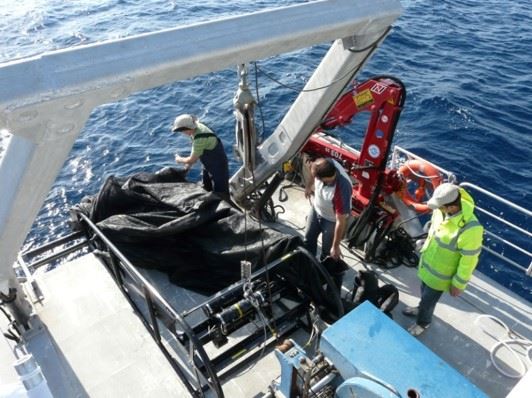Oceanographic and field facilities/equipment:
R/V Sam Rothbergs (see figure below) - A 16 m long research catamaran with twin engines allowing cruising speed of 10 knots. The ship is equipped with state-of-the-art oceanographic instruments and sensors, including a recording sonar, a navigation system, a 1 ton winch with 2 km conductive wire, CTD, a rosette with 11 Niskin bottles, sea-water pump, a water-filtration manifold.
Boats - two 7 m long skiffs built to carry divers and light operations such as water sampling at single depths, plankton tows, mooring deployments, and more.
Remotely Operated Vehicle (ROV)s (see figure below) - A vehicle for explorations and experiments in up to 300 m depth (scheduled to be upgraded to 1000 m). The ROV is equipped with a HD video camera, advanced navigation and logging system, and a manipulative arm for sampling and experiment deployments. It is operated from the R/V Sam Rothberg using a fiber-optics umbilical cable. The ROV, purchased jointly with EcoOcean, a non-profit organization operating in the Mediterranean Sea, will be operated half of the time in the Gulf of Eilat and half of the time in the Mediterranean Sea.
ZOOPS-Op: An advance system for in situ zooplankton studies developed at Jules Jaffe’s lab (Scripps Institute of Oceanography, UC San Diego, USA). The system consists of 4 sonars and 2 cameras to record simultaneous 3D images and acoustic targets at high rates (typically 1 Hz). The system can be used for autonomous profiling down to 500 m depth or on mooring using power & data cable (150 m long).
MOCNESS – Multiple Opening-Closing Net and Environmental Sensing System for sampling zooplankton.
Video Plankton Recorders - towed by the ship, to carry long and fast out video transects of zooplankton at different depths.
Plankton nets - A set of single-mouth plankton nets.
TSK Flowmeters - for plankton nets.
Light traps – to trap zooplankton during the night.
Sediment grabs:
Multi-corer (GOMEX) - to obtain 4 sediment cores from soft bottoms at any depth.
Piston corers – to sample single sediment cores.
Wave pressure gauges (RBRsolo D & RBRsolo10k D | Depth Logger) – to record time series of wave heights and frequencies.
Current meters – Two Acoustic Doppler Current Profilers (ADCPs), two electromagnetic current meters (S4), and Aquadop current profiler.
Underwater cameras:
Cabled underwater video cameras – with cables to shore labs and u/w lighting system.
Underwater PAM – to measure coral fluorescence.
Underwater spectral light meter.
Laboratory instruments:
Bench-top lab PIV.
Advanced video cameras.
For any questions or consultation regarding the equipment and how to use it, please contact Asaph Rivlin:
Email: asaph.rivlin@mail.huji.ac.il
Phone: +972-08-6360144
For booking the boats via the Reservation system: Click here
